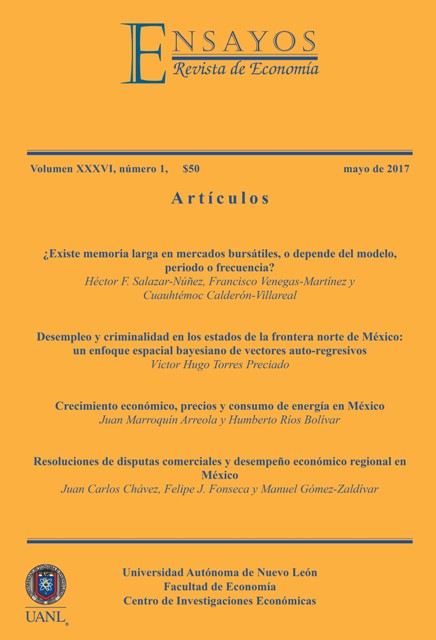¿Existe memoria larga en mercados bursátiles, o depende del modelo, periodo o frecuencia? (Is there Long Memory in Stock Markets, or Does it Depend on the Model, Period or Frequency?)
DOI:
https://doi.org/10.29105/ensayos36.1-1Palabras clave:
Mercados bursátiles, Memoria larga, Métodos econométricos de series de tiempoResumen
El presente trabajo cuestiona si realmente existe memoria larga en los principales mercados accionarios del mundo y, en caso de que esta exista, a qué se debe: ¿al tipo de modelos econométricos empleados, al periodo o la frecuencia de los datos? Para ello, se realiza un análisis comparativo entre modelos ARFIMA y GARCH. Los únicos mercados que mostraron resultados consistentes de memoria larga, independientemente del método, periodo y frecuencia, fueron China y Corea del Sur. El primero tiene memoria larga y el segundo, corta.Descargas
Citas
Anoruo, E., and Gil-Alana, L. A. (2011). Mean Reversion and Long Memory in African Stock Market Prices. Journal of Economics and Finance, 35(3), 296-308.
Baillie, R. T., Bollerslev, T., and Mikkelsen, H. O. (1996). Fractionally Integrated Generalized Autoregressive Conditional Heteroskedasticity. Journal of Econometrics, 74(1), 3-30.
Barkoulas, J. T., Baum, C. F., and Travlos, N. (2000). Long Memory in the Greek Stock Market. Applied Financial Economics, 10(2), 177-184.
Bhattacharya, S. N., and Bhattacharya, M. (2012). Long Memory in Stock Returns: A Study of Emerging Markets. Iranian Journal of Management Studies, 5(2). 67-88.
Beran, J. (1994). Statistics for Long-Memory Processes. Vol. 61. CRC Press.
Bloomfield, P. (1985). On Series Representations for Linear Predictors. The Annals of Probability, 13(1), 226-233.
Bollerslev, T. (1986). Generalized Autoregressive Conditional Heteroskedasticity. Journal of econometrics, 31(3), 307-327.
Cheung, Y. W., and Lai, K. S. (1995). A Search for Long Memory in International Stock Market Returns. Journal of International Money and Finance, 14(4), 597-615.
Danilenko, S. (2009). Long-Term Memory Effect in Stock Prices Analysis. Economics and Management, 14. 151-155
Dickey, D. A., and Fuller, W. A. (1979). Distribution of the Estimators for Autoregressive Time Series with a Unit Root. Journal of the American statistical association, 74, 427-431.
Granger, C. W., and Hyung, N. (2004). Occasional Structural Breaks and Long Memory with an Application to the S&P 500 Absolute Stock Returns. Journal of empirical finance, 11(3), 399-421.
Granger, C. W., and Joyeux, R. (1980). An Introduction to Long‐Memory Time Series Models and Fractional Differencing. Journal of time series analysis, 1(1), 15-29.
Geweke, J., and Porter‐Hudak, S. (1983). The Estimation and Application of Long Memory Time Series Models. Journal of time series analysis, 4(4), 221-238.
Hamilton, J. D. (1994). Time Series Analysis, Vol. 2. Princeton: Princeton University Press.
Henry, O. T. (2002). Long Memory in Stock Returns: Some International Evidence. Applied Financial Economics, 12(10), 725-729.
Higuchi, T. (1988). Approach to an Irregular Time Series on the Basis of the Fractal Theory. Physica D: Nonlinear Phenomena, 31(2), 277-283.
Himpel., K.W. and McLeod, A. I. (1978). Preservation of the Rescaled Adjusted Range. 2. Simulation Studies Using Box-Jenkins Models. Water Resour. Res. 14, 509-516
Hiremath, G. S., and Kamaiah, B. (2011). Testing Long Memory in Stock Returns of Emerging Markets: Some Further Evidence. Economics, Management and Financial Markets, 6(3). 36-147.
Hosking, J. R. (1981). Fractional Differencing. Biometrika, 68(1), 165-176.
Hu, Y., and Øksendal, B. (2003). Fractional White Noise Calculus and Applications to Finance. Infinite Dimensional Analysis. Quantum Probability and Related Topics, 6(01), 1-32.
Hurst, H. E. (1951). Long-Term Storage Capacity of Reservoirs. Trans. Amer. Soc. Civil Eng., 116, 770-808.
Kwiatkowski, D., Phillips, P. C., Schmidt, P., and Shin, Y. (1992). Testing the Null Hypothesis of Stationarity against the Alternative of a Unit Root: How Sure Are We that Economic Time Series Have a Unit Root? Journal of econometrics, 54(1), 159-178.
Lee, D., and Schmidt, P. (1996). On the Power of the KPSS Test of Stationarity against Fractionally-Integrated Alternatives. Journal of econometrics, 73(1), 285-302.
Machinea, J. L. (2009). La crisis financiera internacional: su naturaleza y los desafíos de política económica. CEPAL, 33. 34-96
Malkiel, B. G., and Fama, E. F. (1970). Efficient Capital Markets: A Review of Theory and Empirical Work. The journal of Finance, 25(2), 383-417.
Mian, A., and Sufi, A. (2008). The Consequences of Mortgage Credit Expansion: Evidence from the 2007 Mortgage Default Crisis. National Bureau of Economic Research, No. w13936.
Mukherjee, I., Sen, C., and Sarkar, A. (2011). Long Memory in Stock Returns: Insights from the Indian Market. International Journal of Applied Economics and Finance, 5(1), 62-74.
Oh, G., Um, C. J., and Kim, S. (2006). Statistical Properties of the Returns of Stock Prices of International Markets. arXiv preprint physics/0601126. http://128.84.21.199/pdf/physics/0601126.pdf
Palma, W. (2007). Long-Memory Time Series: Theory and Methods, Vol. 662. John Wiley & Sons.
Peters, E. E. (1994). Fractal Market Analysis: Applying Chaos Theory to Investment and Economics. Vol. 24, John Wiley & Sons.
Peters, E. E. (1996). Chaos and Order in the Capital Markets: a New View of Cycles, Prices, and Market Volatility. Vol. 1. John Wiley & Sons.
Robinson, P. M. (1995). Gaussian Semiparametric Estimation of Long Range Dependence. The Annals of statistics, 23(5), 1630-1661.
Sadique, S., and Silvapulle, P. (2001). Long‐Term Memory in Stock Market Returns: International Evidence. International Journal of Finance and Economics,6(1), 59-67.
Saleem, K. (2014). Modeling Long Memory In The Russian Stock Market: Evidence From Major Sectoral Indices. Journal of Applied Business Research (JABR), 30(2), 567-574.
Shimotsu, K., and Phillips, P. C. (2002). Pooled log Periodogram Regression. Journal of Time Series Analysis, 23(1), 57-93.
Sowell, F. B. (1992) Maximun Likelihood Estimation of Stationary Univariante Fractionally Integrated Time Series Models. Journal of Econometrics, 53, 165-188.
Taqqu, M. S., Teverovsky, V., and Willinger, W. (1995). Estimators for Long-Range Dependence: an Empirical Study. Fractals, 3(04), 785-798.
Tolvi, J. (2003). Long memory in a Small Stock Market. Economics Bulletin,7(3), 1-13.
Descargas
Publicado
Cómo citar
Número
Sección
Licencia
Derechos de autor 2017 Héctor F. Salazar-Núñez, Francisco Venegas-Martínez, Cuahutémoc Calderón-Villareal

Esta obra está bajo una licencia internacional Creative Commons Atribución 4.0.
















